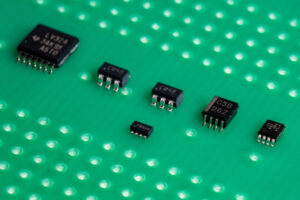Texas Instruments (TI) unveiled programmable logic devices (PLDs), which enable engineers to simplify their logic designs for any application and build on its industry-leading logic portfolio.
Compared to discrete logic solutions, TI’s new PLD portfolio is said to help reduce board space by up to 94% and system costs by integrating up to 40 combinational and sequential logic and analog functions into a single device.
In addition, the new portfolio provides notable space reductions over comparable programmable logic devices available in the market.
Without requiring any software coding, engineers may quickly design, simulate, and configure their devices for evaluation by utilizing TI’s user-friendly InterConnect Studio tool. With an integrated simulation capability and a drag-and-drop GUI, InterConnect Studio speeds up the logic design process.
Click-to-program and direct ordering features, which streamline procurement and programming and shorten time to market, are also advantageous to designers.
The smallest leaded package in the market, measuring 2.1 mm by 1.6 mm with a 0.5 mm pitch, is part of TI’s PLD portfolio. This leaded package is 92% smaller than similar products, providing the requirement for solderability from manufacturers in a much smaller size.
Automotive-grade PLDs from TI are up to 63% smaller than those from their nearest competitors. In order to ensure long-term system reliability and safety, the portfolio now includes quad flat no-lead (QFN) packaging choices that allow automated optical inspection.
TI has developed new PLDs that have a low power consumption of less than 1µA and 50% less active power than comparable devices available on the market. These devices can be used in goods like gaming controllers, power tools, electric vehicles, and battery packs to help prolong battery life.
General-purpose input/output, look-up tables, digital flip-flops, filters, pipe delays, and resistor-capacitor oscillators are all supported by TI’s new PLDs. Along with internal configurable voltage reference options, hysteresis, and analog comparators, the TPLD1201 and TPLD1202 devices also incorporate these features. Additional features including a watchdog timer, state machine, I2C, and Serial Peripheral Interface are provided by the TPLD1202.
Availability
Preproduction quantities of TI’s new PLDs are available at TI.com. The table below provides details and pricing in 1,000-unit quantities. Additionally, development tools include:
- · Evaluation modules for purchase on TI.com for US$69.
- · A USB programmer for US$59.
- · InterConnect Studio, as a free download on TI.com.
Device |
Package |
Price |
Evaluation module |
| TPLD801 | SOT – 8-pin | US$0.19 | TPLD801-DRL-EVM |
| TPLD801-Q1 | SOT – 8-pin | US$0.224 | TPLD801-DRL-EVM |
| TPLD1201 | VSSOP – 10-pin | US$0.34 | TPLD1201-DGS-EVM |
| QFN – 12-pin | US$0.38 | TPLD1201-RWB-EVM | |
| TPLD1201-Q1 | VSSOP – 10-pin | US$0.40 | TPLD1201-DGS-EVM |
| TPLD1202
|
SOT – 14-pin | US$0.44 | TPLD1202-DYY-EVM |
| QFN – 12-pin | US$0.48 | TPLD1202-RWB-EVM | |
| TPLD1202-Q1 | SOT – 14-pin | US$0.52 | TPLD1202-DYY-EVM |
Key Comments
“Engineers are increasingly considering programmable logic devices as a way to reduce design complexity and board space, simplify supply chain management, and accelerate their time to market,” said Tsedeniya Abraham, VP and GM of Interface at TI. “But existing programmable logic devices are more complex than many applications require, involve programming expertise, or they come in limited packaging options. Our new programmable logic portfolio builds on TI’s 60 years of experience in logic design and offers small form factors in industry-standard packaging as small as 2.56mm2, low power consumption, AEC Q-100 qualification and a temperature range of -40°C to 125°C for applications including automotive, industrial and personal electronics.”
For Further Info, CLICK HERE



